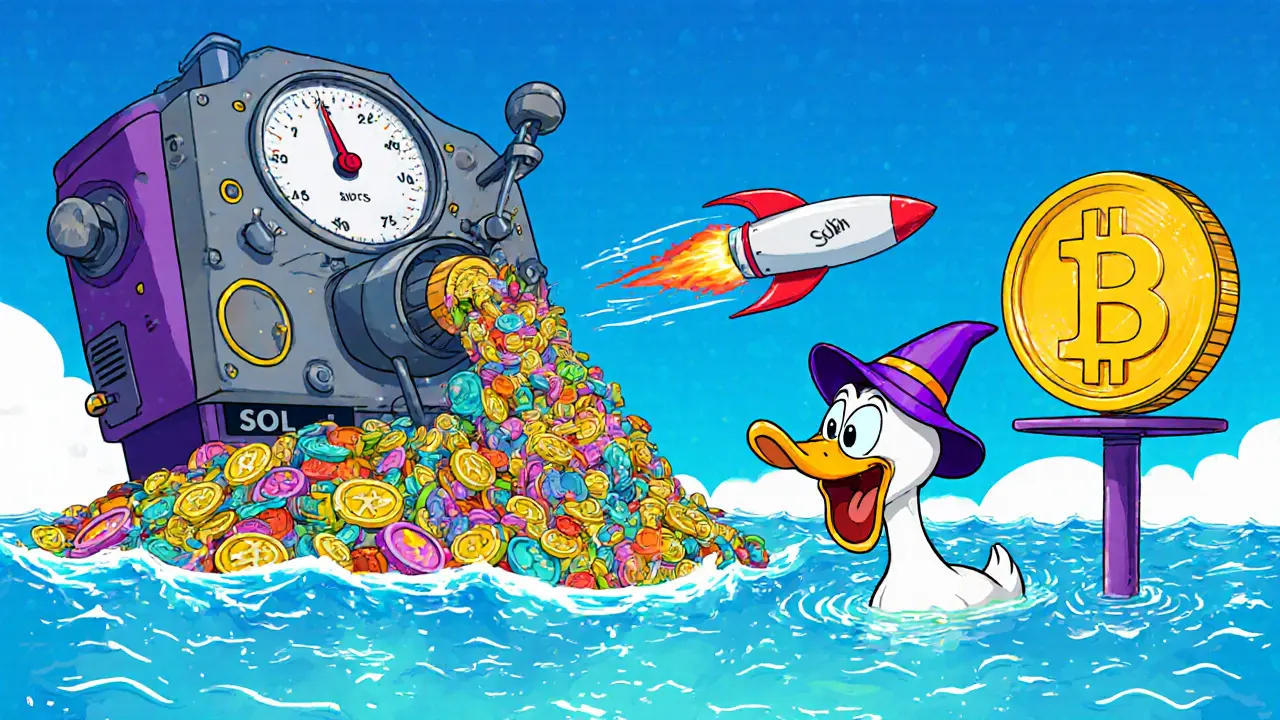
Solend (SLND) Yield Calculator
Quick Summary
- Solend is a decentralized, algorithmic lending protocol built on Solana.
- The native token SLND is used for governance and fee distribution.
- Users can earn interest on deposits or borrow against over‑collateralized assets.
- Fast, cheap transactions set Solend apart from Ethereum‑based lenders.
- Security upgrades after a 2022 oracle attack make the platform more resilient.
When you hear the name Solend is a decentralized lending protocol on the Solana blockchain that lets anyone earn yield on idle crypto or borrow against collateral, you might wonder how it fits into the crowded DeFi landscape. This guide breaks down the protocol’s core mechanics, the role of the SLND token, key advantages, risks, and how you can start using it today.
What is Solend and Why Does It Matter?
Solend positions itself as Solana’s “autonomous interest‑rate machine.” Launched in August2021, the platform mirrors Ethereum’s Aave and Compound but leverages Solana’s high‑throughput, low‑fee environment. The protocol currently supports 136 assets across 29 lending pools, with more than $400million borrowed and $178million supplied (as of early2025). Its native token, SLND (Solend Token), grants holders voting power over protocol upgrades and a share of the platform’s fee revenue.
How Does the Solend Protocol Work?
Solend operates on a pool‑based model. Anyone can deposit a supported asset into a pool and start earning interest immediately. Interest rates are not fixed; they’re calculated by a piecewise function that reacts to supply‑and‑demand dynamics within each pool. When you borrow, you must over‑collateralize-typically at a loan‑to‑value (LTV) ratio of 70‑80%. If the value of your collateral falls below the required threshold, the protocol automatically liquidates enough of it to protect lenders.
The key steps for a user are:
- Connect a Solana wallet (e.g., Phantom or Solflare) to the Solend web UI.
- Select an asset you want to deposit or borrow.
- Approve the transaction; Solana’s sub‑second finality means the action is confirmed almost instantly.
- Monitor your position via the dashboard to avoid liquidation.
Developers can tap into Solend’s open‑source SDK to embed lending functionality directly into their dApps, making it a popular building block for GameFi, payroll streaming, and margin‑trading solutions.
Key Features and Advantages
- Speed and Cost: Transactions settle in under a second and cost a few hundredths of a cent, far cheaper than Ethereum’s gas fees.
- Broad Asset Coverage: 136 assets include major tokens (USDC, SOL, wBTC) and niche Solana‑native projects.
- Algorithmic Rates: Dynamic interest rates keep the market efficient without manual adjustments.
- Governance: SLND holders vote on parameter tweaks, new asset listings, and fee distributions.
- Yield Strategies: Integrated vaults let users auto‑compound earnings or lock assets for higher fixed returns.

Security History and Risk Factors
In November2022 Solend suffered an oracle attack that created $1.26million of bad debt. The incident forced a temporary shutdown of affected pools and prompted a major protocol revision. Version2, released in April2023, introduced stronger price‑feed validation, tighter liquidation thresholds, and a revamped risk‑management module.
Despite these upgrades, users should still consider the following risks:
- Network Dependency: Outages on the Solana chain can freeze deposits or prevent liquidations.
- Smart‑Contract Bugs: As with any DeFi code, undiscovered vulnerabilities could lead to loss.
- Market Volatility: Sharp price swings can trigger rapid liquidations, especially for high‑LTV positions.
- Liquidity Gaps: Smaller pools may not have enough depth to absorb large withdrawals.
Step‑by‑Step: Using Solend Today
Here’s a quick walkthrough for a new user who wants to earn interest on USDC:
- Install a Solana wallet extension (Phantom is the most common).
- Buy USDC on a supported exchange and transfer it to your wallet.
- Visit app.solend.fi and connect your wallet.
- Locate the USDC pool, click “Deposit,” specify the amount, and confirm the transaction.
- The UI will display your accrued interest in real time; you can withdraw at any moment.
Borrowers follow a similar flow but must first supply collateral (e.g., SOL) before requesting a loan. The platform shows the projected LTV and liquidation price, helping you keep a safe buffer.
Solend vs. Other DeFi Lenders
To see where Solend stands, compare it with two of the biggest Ethereum‑based protocols:
| Metric | Solend (SLND) | Aave | Compound |
|---|---|---|---|
| Blockchain | Solana | Ethereum | Ethereum |
| Supported Assets (2025) | 136 | 95 | 85 |
| Total Value Locked (TVL) | $567M | $13B | $10B |
| Average Transaction Fee | ≈$0.0002 | ≈$12 | ≈$10 |
| Transaction Speed | ~400TPS (sub‑second finality) | ~15TPS | ~15TPS |
| Governance Token | SLND | AAVE | COMP |
Solend’s biggest advantage is cost and speed, while its TVL lags behind the Ethereum giants. For users who prioritize cheap, fast trades and already hold Solana assets, Solend often makes more sense.
Future Outlook and the Save Finance Rebrand
In early2025 Solend announced a rebrand to Save Finance, keeping the SLND token unchanged. The new branding aims to attract a broader audience beyond pure lending, positioning the platform as a full‑suite savings and credit service.
Backing remains strong: investors like Polychain Capital, Coinbase Ventures, and Alameda Research have committed capital and advisory support. As Solana’s ecosystem grows-especially with upcoming Layer‑2 rollups and cross‑chain bridges-Solend/Save Finance stands to capture a larger slice of DeFi lending.
Key factors to watch:
- Adoption of Solana’s upcoming version2.0, which promises even lower latency.
- Further integration with on‑ramp services that make fiat‑to‑Solana deposits seamless.
- Regulatory developments around crypto lending in major jurisdictions.
Quick Tips for New Users
- Keep your LTV below 70% to avoid sudden liquidations.
- Use the “Health Factor” metric on the dashboard as an early warning sign.
- Consider diversifying across multiple pools to mitigate asset‑specific risk.
- Stay updated on protocol upgrades-most changes are announced on the official Discord and Medium.
- If you hold SLND, stake it in the governance portal to earn a share of borrow fees.

Frequently Asked Questions
What is the main purpose of the SLND token?
SLND serves as the governance token for the Solend protocol. Holders can vote on proposals such as new asset listings, fee adjustments, and protocol upgrades. Additionally, a portion of the platform’s borrowing fees is distributed to staked SLND holders, creating a passive income stream.
How does Solend keep transaction fees so low?
Solend runs on Solana, a high‑throughput blockchain that processes thousands of transactions per second for just a fraction of a cent. The protocol’s smart contracts are optimized for Solana’s runtime, which avoids the gas‑price spikes seen on Ethereum.
Can I withdraw my deposit at any time?
Yes. Deposits are liquid and can be withdrawn instantly from the UI or via the SDK, as long as the pool has sufficient liquidity. Withdrawal requests settle in seconds because of Solana’s fast finality.
What happened during the 2022 oracle attack?
An attacker manipulated the price feed for a specific asset, causing the protocol to under‑price collateral and generate $1.26million in bad debt. Solend responded by pausing the affected pools, revamping its oracle architecture, and launching version2 with stricter validation rules.
Is Solend safe for long‑term holding?
Safety depends on several factors: the security of Solana’s network, smart‑contract audits, and your own risk management (e.g., maintaining healthy collateral ratios). Since the 2023 upgrade, the protocol has passed multiple independent audits, but, like any DeFi service, it carries inherent risk.

Stefano Benny
May 18, 2025 AT 04:50Everyone’s screaming about Solend’s sky‑high APY, but the hidden alpha is the Solana validator churn that can vaporize collateral in a flash. The protocol’s liquidity pool depth is still shallow compared to legacy CeFi, so you’re chasing yield on a ramp that could stall any second. 🙄💹
Jenae Lawler
May 23, 2025 AT 06:11While the aforementioned concerns are noted, one must recognize that Solend operates within a rigorously audited smart‑contract framework, thereby mitigating systemic exposure. Moreover, the tokenomics have been meticulously calibrated to balance incentive alignment with capital efficiency. Consequently, any cursory dismissal neglects the nuanced equilibrium achieved by the development consortium.
Prince Chaudhary
May 28, 2025 AT 07:31Let’s keep the discussion constructive and remember that the yield calculator is a great tool for visualizing potential returns. Even with network volatility, diversifying through Solend can enhance a portfolio’s resilience.
Jayne McCann
June 2, 2025 AT 08:51Honestly, the calculator feels like a gimmick that oversimplifies the real risks.
Bobby Ferew
June 7, 2025 AT 10:12The hype train is full of buzzwords like “decentralized liquidity” and “ultra‑high yield,” yet the underlying protocol still hinges on fragile on‑chain oracle feeds. It’s a classic case of marketing gloss over substantive risk.
celester Johnson
June 12, 2025 AT 11:32In the grand tapestry of financial innovation, Solend is but a fleeting motif, its allure fading once the novelty wears off. One must question whether the promised returns are a mirage or a genuine paradigm shift.
John Kinh
June 17, 2025 AT 12:52Meh, same old hype. 😒
Mark Camden
June 22, 2025 AT 14:13Contrary to your flippant assessment, Solend’s protocol architecture incorporates layered risk buffers, including over‑collateralization ratios and liquidation safeguards, which collectively temper exposure. Dismissing these mechanisms overlooks the diligent engineering underpinning the platform.
Evie View
June 27, 2025 AT 15:33The community’s blind devotion is unsettling; they ignore the fact that token price volatility can decimate staking rewards in seconds. Wake up and see the numbers for what they truly are.
Sidharth Praveen
July 2, 2025 AT 16:54Even if the market swings wildly, staying the course and adjusting positions can still yield respectable gains. Keep your eyes on the long‑term horizon.
Sophie Sturdevant
July 7, 2025 AT 18:14Leverage the platform’s staking incentives and liquidity mining programs to compound your earnings; the APY isn’t static, it reacts to supply‑demand dynamics. By rebalancing regularly, you can ride the yield curve efficiently.
Nathan Blades
July 12, 2025 AT 19:34When you first glance at Solend’s dashboard, the bright numbers can feel like a siren call to any yield‑hunter. But beneath that glossy veneer lies a complex interplay of tokenomics, market depth, and network latency. The SLND staking bonus, for instance, isn’t a fixed percentage; it fluctuates with the protocol’s governance votes and overall token circulation. This means that yesterday’s 12% APY could taper to 8% if the community decides to redistribute rewards to liquidity providers. Understanding this dynamic requires digging into Solend’s on‑chain governance proposals, which are publicly archived but rarely digested by casual users. Moreover, the underlying Solana blockchain, while fast, has demonstrated periodic congestion that can delay transaction finality. Such delays, albeit milliseconds in normal operation, can compound during market stress, potentially affecting liquidation triggers. If you’re over‑collateralized by a narrow margin, a sudden slowdown could push your position into the liquidation zone before you have a chance to top up. That’s why many seasoned DeFi traders keep a buffer of at least 150% collateral when using Solend. Another subtle risk is the reliance on price oracles, which, although decentralized, can be temporarily out‑of‑sync with external markets. When an oracle lag occurs, the protocol might misprice assets, leading to unintended arbitrage opportunities or loss of capital. Balancing these concerns, Solend does offer a suite of risk‑mitigation tools, such as automated rebalancing bots and insurance pools. Deploying a rebalancing strategy can automatically adjust your collateral ratios in response to price swings, reducing manual intervention. Finally, diversification remains your best defense: allocate only a portion of your portfolio to Solend while maintaining exposure to more stable assets. In short, Solend can be a lucrative component of a broader DeFi playbook, but only if you respect its intricacies and stay vigilant.
Somesh Nikam
July 17, 2025 AT 20:55I recommend reviewing the latest governance snapshot before committing additional capital; it provides clear insight into upcoming reward adjustments. 📊
Jan B.
July 22, 2025 AT 22:15Good point the snapshot shows the pending changes and helps avoid surprise rate drops
MARLIN RIVERA
July 27, 2025 AT 23:35The data clearly indicates that Solend’s projected yields are statistically insignificant when accounting for Solana’s network fees and slippage.
Debby Haime
August 2, 2025 AT 00:56Don’t let the numbers scare you; with a disciplined approach you can still capture decent returns while managing fees wisely.
emmanuel omari
August 7, 2025 AT 02:16As an American investor, I appreciate platforms that prioritize transparency and robust security, and Solend’s open‑source code meets those criteria admirably.
Andy Cox
August 12, 2025 AT 03:36yeah it’s cool but don’t forget the global market can shift fast
Courtney Winq-Microblading
August 17, 2025 AT 04:50In the kaleidoscope of decentralized finance, Solend shines like a phosphorescent tide, inviting us to swim deeper into the currents of collective liquidity.